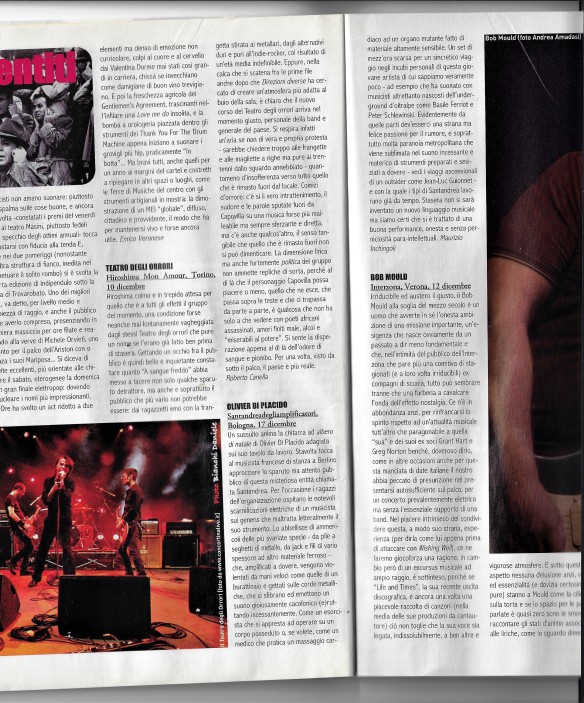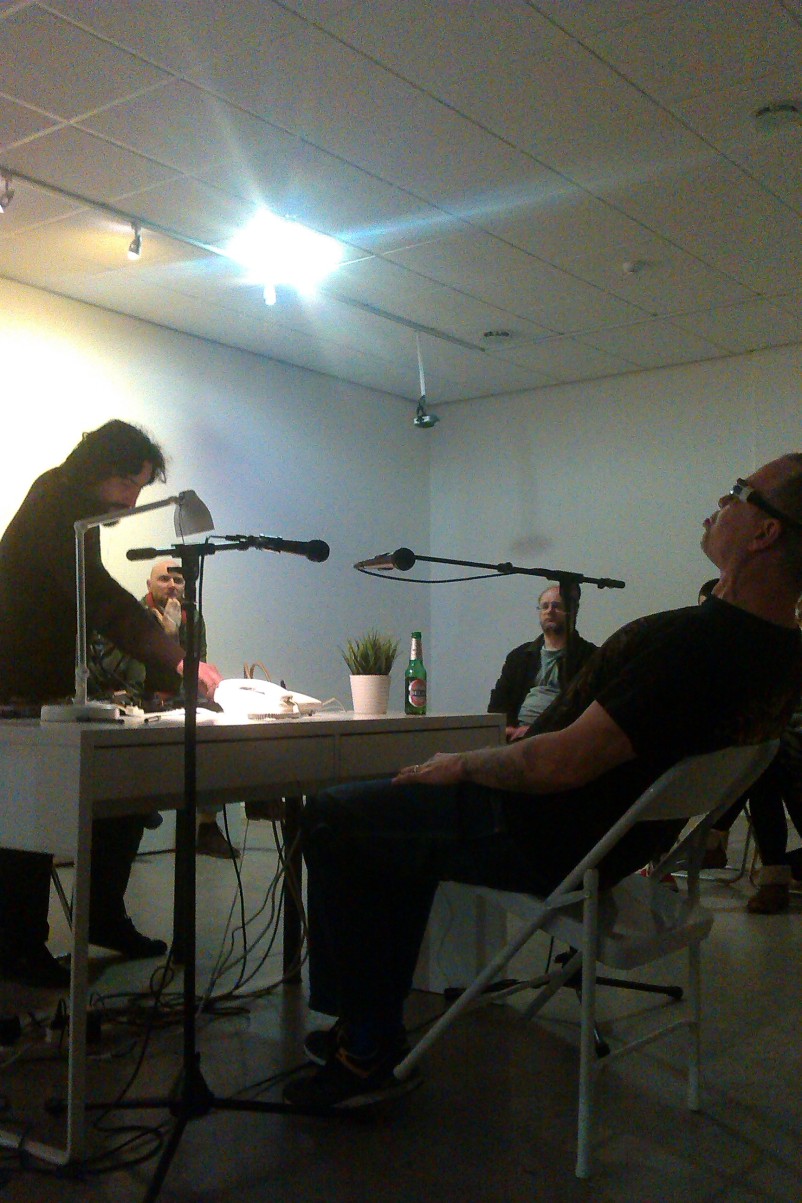
———–Blow Up #141, feb 2010————————————————————————————————————————————————————————————————————————————————————————
Fritz Welch & Olivier Di Placido live @ Fuse Art Space, Bradford in The UK.(12.04.2015)
“High-Speed Electronic Music and Freedom From Memory.
.
Two performers sit across from one another at a table. Before one of them lays what looks like a guitar subjected to an alien autopsy – neck partially detached and laying on the table at a broken angle, strings sticking out of where a pickup was, and into the output jack of the guitar, clipped to a contact mic. A pair of stereo induction coils hangs dangling from a bright desk light, waving back and forth over where the other pickup has been stretched across the table, connecting to miscellaneous other wires and what looks like a crystal radio kit. The other performer sits across from the first, with only a stereo pair of microphones. He lowers his goggles over his eyes, and the concert begins.
Fritz Welch opens his mouth wide, and Olivier Di Placido sets forceps to his guitar. That was the beginning of the concert at Fuse Gallery in Bradford, UK. The improvised waterfall of actions that then erupted achieved several things simultaneously. History and future possibility collapsed into the present moment of the performance, the way a wave equation in quantum physics collapses around whether or not Schrodinger’s cat , to reveal its capacity or incapacity to boogie in its box. Sounds were of a wide range of volumes, though in general short and quickly presented, favoring movement over development of individual tones or textures. Blending was not sought, and the brief sound events did not generally overlap, though they did cohere. Neither samples, nor reverb or echo seemed to be used, but acoustic sounds blended with a fully conscious use of the loudspeakers, energizing the full available sound field of the room. Harmonic sounds or progressions where all but non-existent. The performers de-constructed instruments and techniques in real time, streamrolling any harmonic grounding in the noises presented. This was live electronic music, and with an organic sense of perpetual surprise it created crackled a joyful avoidance of memory or structural association. After the concert, I realized that this result was rather close in intention to the earliest experimental electronic music.
In 1939 John Cage published Imaginary Landscape 1 for cymbal, piano, variable-speed turntables, and frequency recordings. No live electronic sound generation was used, but the score provided a method for a live performance. This work, a touchstone for turntablists, not only introduced the idea of sampling into performance, but more importantly created a structure by which people could play live electronic sounds. The score is less meant to be a recipe for the creation of a specific sound, but rather a process for opening a window onto an unknown landscape, a process which continues and broadens in later Imaginary Landscape pieces, as well as pieces such as Fontana Mix or the Variations series to follow, where this is made clear through a total use of chance operations, to determine, in some cases, everything. The emphasis is on the live moment, with its implicit unpredictability.
In works created between the late 50s and 1980s David Tudor, Cage’s collaborator, created many live electronic works with and for the Sonic Arts Union and the Merce Cunningham Dance Company. Tudor is known largely as a performer rather than a composer due to the lack of scores and recordings of his music, though it is well known that he designed circuits and electronic instruments, created some of the first sound installations, and performed electronic music live. He is also known to have been a meticulous and exacting interpreter of music, who would create performance scores of indeterminate works arranged according to strict timeline and even tried to re-create the Woodstock 1952, conventionally notated manuscript of 4’33” by John Cage (Fetterman 1996, 74). If Tudor left behind few scores, nor many recordings of his electronic music, one must assume that this decision was purposeful,and that his intention was on a process, an activity, rather than a particular sounding object.
Welch and Di Placido similarly use no score in performance. Yet this is not free improvisation, for although they deconstruct their instruments and vocabularies before the audience, they are clearly responding to their own learned techniques and histories in the choices they make in working with the sounds, and in response. What is presented are specific processes rather than specific pieces. These processes, though based on each individual artist’s learned practice, purposefully retain chance elements, whose resistance results in a plentitidue of unforeseen or possible outcomes. These processes frustrate memory and association, resulting in a virtuosic acceptance of all sounds on the part of both performers and audience that in turn facilitate the exploration of new experiences of sound and time. Gordon Mumma has suggested that live electronic music is a contemporary folk-art practice. In Welch and Di Placido’s music, attention to the sounding presence of the moment suggests something akin to traditional art forms whose goal is transcendental states, but for Welch and Di Placido this exists without nostalgia and with a minimum of tradition. Wlech and Di Placido are giving us the present, and the present is in process, is process.”
Article and photo by Jorge Boehringer originally published here.

